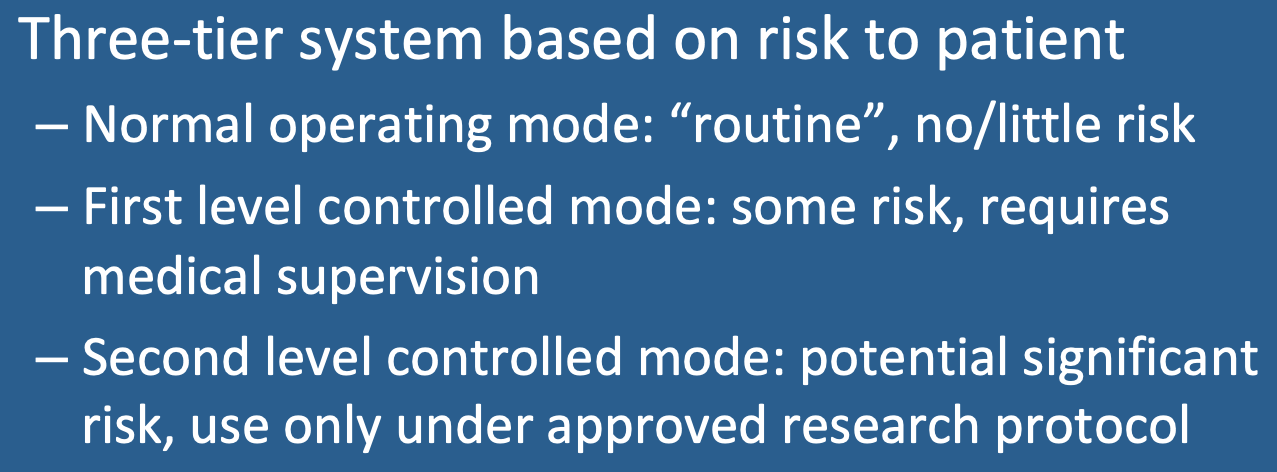- Normal operating mode. This is the "routine" level at which most clinical MRI today is performed, being considered safe for all patients, regardless of their condition.
- First level controlled operating mode. This level is defined as one where certain imaging parameters may cause physiologic stress (such as peripheral nerve stimulation or tissue heating). Active medical supervision is required to use this mode to insure that a careful assessment of benefits vs risks have been assessed. The FDA requires equipment operating in this mode to display and record dB/dt and SAR levels, and display a warning that the first level mode is about to be reached. The MR scan operator must acknowledge this at the console before being allowed to proceed with the scan.
- Second level controlled operating mode. Also called "research" or experimental" mode, this level is reached when such operation may produce significant risks to patients. Second level mode may only be used under an appropriate ethics/human studies protocol. Special security measures (such as software password lock) must be used to prevent unauthorized operation in this mode.

Advanced Discussion (show/hide)»
The International Electrotechnical Commission Standard (IEC 60601-2-23:2015) has set the prevailing limits for gradient exposure, also adopted by many other organization such as the US Food and Drug Administration (FDA). The IEC provides several methods to satisfy their requirements:
1. Default dB/dt limits for whole body systems.. Use the threshold equation [dB/dt]TH = rheobase x (1 + 0.36/tsamp) with rheobase of 20 T/s where tsamp is the stimulus duration time in msec. Gradient output limits for Normal Operating Mode and First Level Controlled Mode are defined as 80% and 100% of these values respectively.
2. Default electric field (E) limits for all gradient systems.. Use the threshold equation [E]TH = rheobase x (1 + 0.36/tsamp) with rheobase of 2.2 V/m where tsamp is the stimulus duration time in msec. Gradient output limits for Normal Operating Mode and First Level Controlled Mode are defined as 80% and 100% of these values respectively.
3. Direct determination in volunteers. (This can apply to both whole body and special purpose gradients.) Using different pulse durations and axes, PNS stimulation thresholds are established in at least 11 volunteers. Gradient output limits for Normal Operating Mode and First Level Controlled Mode are defined as 80% and 100% of the lowest PNS perception level recorded.
IEC Cardiac Stimulation Limits. The IEC uses an exponential model for cardiac limits. (A hyperbolic model is used for PNS). The relevant equation is E < 2 ÷ [1 − exp(−tstim/3)]
International Electrotechnical Commission. IEC 60601-2-33:2010: Medical Electrical Equipment - Part 2-33: Particular Requirements for the Basic Safety and Essential Performance of Magnetic Resonance Equipment for Medical Diagnosis. 3rd ed. with amendments. International Electrotechnical Commission; 2015. (accessed July 2020)
Health Protection Agency. Protection of patients and volunteers undergoing MRI procedures. Documents of the Health Protection Agency Radiation, Chemical and Environmental Hazards, August 2008. [link]
Medicines and Healthcare Products Regulatory Agency (MHRA). Safety guidelines for magnetic resonance imaging equipment in clinical use. 2015. (See Appendix 2 for comparison of exposure limits suggested by HPA, IEC, and ICNIRP) [link]
Who regulates/sets standards for MRI equipment and safety?
